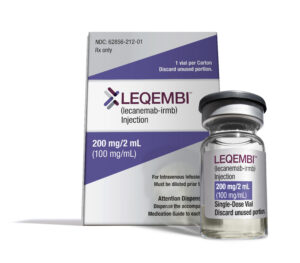
Many reporters on the health beat face tight deadlines to publish stories based on press releases from the pharmaceutical industry about new study results and regulatory approvals.
Companies understandably want to put the best spin on data in their releases. But it’s our job to put study results in context and inform our audiences about what key information has yet to be revealed.
For this reason, we offer four tips for helping your readers, listeners and viewers get a more complete understanding of cases where incomplete study data is released.
We’re going to use a Sept. 27 joint press release from drugmakers Eisai and Biogen about a clinical trial called Clarity-AD focused on the Alzheimer’s drug lecanemab as an example.
We’ll give you a little background on this drug and then walk you through our four tips.
Lecanemab is part of a group of closely watched potential Alzheimer’s disease treatments now in advanced testing. These drugs are genetically engineered antibodies designed to reduce amyloid plaque build-ups in the brain. (There’s a larger debate about this approach, as you can read about in this AHCJ post. But in this tip sheet, we’re focusing on the data in the lecanemab press release.)
To test lecanemab, researchers used a tool developed by Washington University Physician John C. Morris, M.D., and colleagues known as the Clinical Dementia Rating (CDR®) Scoring Table, or CDR- Sum of Boxes (SB) scale. Morris has given AHCJ special permission to show the table below to help journalists get a better understanding of how the progression of dementia is measured. But CDR® is a copyrighted and trademarked instrument owned by Washington University, and its use must be licensed by the university.
AHCJ thanks Morris and Washington University for allowing us to use this chart in this article. Please do not copy it.

The CDR-SB tracks how people lose their ability to function over time, looking at six categories: memory, orientation, judgment and problem solving, community affairs, home and hobbies, and personal care.
Getting to know the CDR-SB test will help you give your audience a better understanding of the data companies release on Alzheimer’s drugs.
For example, in the press release, Eisai and Biogen reported “treatment difference in the score change of -0.45,” meaning that the condition of people on lecanemab as a group declined at a slower rate than did that of people given a placebo. The companies several times in the release referred to the statistical significance of different data points from the Clarity-AD study.
But statistical significance is a measure reflecting how certain researchers ruled out chance as a factor of the observed results, and not of the benefits of a drug for patients.
“For lecanemab, statistical significance does not necessarily make for a life-changing medicine. Alzheimer’s researchers have spent years debating just what small changes in CDR-SB scores mean for patients with the disease. A fractional improvement on an 18-point scale could be imperceptible in real life. On the other hand, the metric is not an interval scale, meaning its numerical differences aren’t proportionate to one another. Going from a 1 to a 1.5 on the CDR-SB could mean no longer being able to drive on one’s own, while going from a 14 to a 14.5 would likely make little difference for a patient already in the throes of dementia.”
And this brings us to our first tip.
1. Take a deep breath and make sure you can explain key data to your audience. You likely will need to understand the difference between relative calculations and absolute numbers.
In the September 2022 press release, Eisai said lecanemab “reduced clinical decline on the global cognitive and functional scale, CDR-SB, compared with placebo at 18 months by 27%.”
The 27% figure derives from a calculation based on numbers not provided in the press release, which are the results for each group of patients.
“The 0.45 is 27% of 1.67, so it stands to reason that progression was approximately 1.22 in lecanemab and 1.67 in placebo,” Eisai spokesperson Christopher Vancheri told AHCJ in an email.
In November, the leaders of the Clarity-AD trial published more complete results from the trial. Their paper said the mean CDR-SB score at baseline was about 3.2 in both the group that received the drug and the group that received the placebo.
The scores worsened for both groups, but the rate of decline was less in the Leqembi group. After 18 months, the mean change from baseline score in the Leqembi group was 1.21. There was a mean change of 1.66 difference for the placebo group.
Tara Haelle, AHCJ’s core topic leader for medical studies, makes an excellent point when telling fellow journalists about relative calculations: Think of these numbers as you would a promo for a sale.
A 25% discount on a $2,500 laptop would be a bigger deal than a 25% discount on a $4 cup of coffee. Haelle has posted excellent material to help further explain this, including the discussion of risk seen here. There’s also this easy-to-grasp explanation by Poynter.
2. Alert your audience immediately to the promotional nature of a press release. Explain what key data has not yet been revealed.
Many readers, viewers and listeners may assume any study data reported has been vetted by other experts, as happens with publication in a peer-reviewed journal.
You owe it to them to make it clear when you’re reporting on only limited results of a study.
It may be best to explain the nature of the information being released. The press release is a chance for companies to put the best spin on results, and you can tell your audiences that. Companies face more scrutiny when they publish results in peer-reviewed journals or present study findings at medical conferences.
3. Avoid using references to “statistical significance” unless you are writing for an audience that needs to do a deep dive into the data.
The Eisai and Biogen press release made references to “highly statistically significant results” for lecanemab.
Statistical significance refers to a calculation done in research to estimate how solid the results are to gauge how likely it is that the result was a fluke or due to chance. This is measured by something called a p value, as AHCJ’s Haelle explains here. In medical research, a p value lower than 0.05 is the gold standard. Trials that don’t meet that bar are largely dismissed.
If you are writing for an audience where you would need to explain what a p value is, perhaps consider leaving out references to results being “statistically significant.”
4. Reach out to experts as soon as you can — ideally before you have to write a story on deadline about study results.
Former AHCJ Board President Ivan Oransky, M.D., recommends always having a statistician in your back pocket. That’s great advice from Oransky, who is also a distinguished writer in residence at New York University’s Carter Journalism Institute.
If you can, talk to researchers ahead of time about studies you are likely to cover. We understand the challenges of filing stories on tight deadlines. But it’s always worth reaching out to experts as soon as possible to get help in assessing results of medical studies, even after the release has hit.
Resources for preparing to cover results of studies on drugs:
- Use the ClinicalTrials.gov website to get details about studies of drugs you may be covering. Here’s the listing for Clarity-AD as an example. Call the company and ask to interview its scientists to try to turn medical jargon into simple explanations. You also will find on ClinicalTrials.gov the names of researchers involved the study. They can be good sources as well.
- For this article, AHCJ spoke not only with Oransky, but with Gary Schwitzer, who was the founder and publisher of the now defunct website HealthNewsReview.org, and Steven Woloshin, M.D., co-director of the Center for Medicine and Media at Dartmouth University and the founder of the Lisa Schwartz Foundation for Truth in Medicine.
- In reporting this article, we also reached out to two doctors who have served as members of the Food and Drug Administration (FDA)’s Peripheral and Central Nervous System Drugs Advisory Committee, Madhav Thambisetty, M.D., D.Phil., a senior clinical investigator at the National Institute on Aging (NIA) Laboratory of Behavioral Neuroscience, and David Knopman, M.D., of the Mayo Clinic.
- When reporting on a drug, consider looking for people who have served on relevant FDA advisory committees as sources. The FDA has standing panels of experts in many fields of medicine. These doctors and scientists tend to know very well the approaches taken for testing products in their field.
- Universities and hospitals often involved in medical research can help you find experts as well. Good sources include the media teams at the Mayo Clinic and the National Institutes of Health (NIH).
- Search on PubMed for people who have published papers on the topic about which you are writing.
- These two nonprofit groups can also often help you better understand how companies study their drugs and medical devices: Public Citizen and the National Center for Health Research. Another group to try is PharmedOut, housed at Georgetown University Medical Center.
- If you are writing on Alzheimer’s drugs targeting amyloid, you should read the federal decision memo explaining why Medicare limited coverage of Aduhelm.
Story ideas
- Reach out to an Alzheimer’s caregiver support group and ask participants if they would have opted to encourage their loved one to try Leqembi had it been available when dementia symptoms first appeared. Why or why not?
- Speak with local neurologists and geriatricians; will they offer Lequembi as an option to their patients? Why or why not? How do they feel about the risk/benefit trade-offs?
- Ask to be connected with those newly-diagnosed with Alzheimer’s and discuss whether they are willing to try a potentially risky and expensive drug. Remember, as of mid-May 2023, Medicare said it will only pay for the drug following full approval by the FDA. Are they willing to regularly receive an infusion in a physician’s office or clinic and undergo careful monitoring? What about those who cannot afford the cost of the drug? What accommodations are/will be made to offer it to those in lower-income, often underserved communities in regard to cost, access, ability for someone with a diagnosis (or their caregiver) to take time off from work for treatment, undergo ongoing screening visits, etc.?
- What other promising drugs are in the pipeline that could be an alternative to Leqembi with perhaps fewer side effects and lower treatment costs?
- What programs and services are available in your community to support those with the disease and their caregivers? e.g., Adult Day Centers, respite programs, friendly visitor programs, etc.







